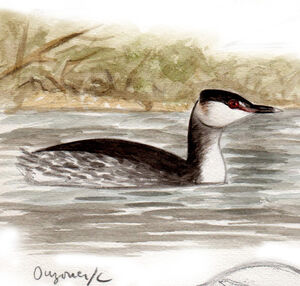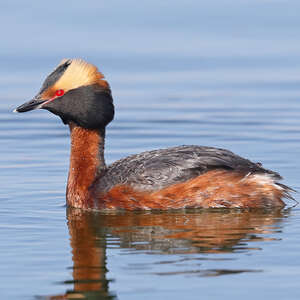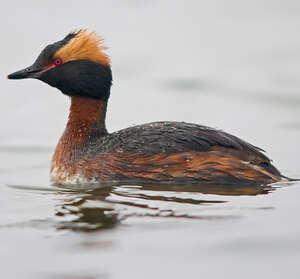Horned Grebe
Podiceps auritus - Grèbe esclavon
Identification
The Horned Grebe is a small grebe, barely larger than the Black-necked Grebe with which it can be confused in winter plumage. The adult in breeding plumage is easily identifiable from the head and neck plumage. The head is black, except for the chestnut lores. The neck is bright chestnut with a black band at the back (the black neck has a black head and neck). The side of the head shows two tufts of long erect feathers, the first of a golden hue behind the eye and the second, a black facial on the cheeks. It owes its English name of Horned Grebe to the first. The beak, with concave culmen and gonys, is almost straight, black and tipped with white - a specific criterion. The eye is bright red and, close-up, a pink line can be seen from the eye to the lower jaw. The sexes are similar - the male just slightly larger than the female.
In winter plumage, the adult loses its bright colours, except for the eye which remains red. The plumage is black, white and grey. It's the head that should be looked at to distinguish it from the black neck. The crown is flat, never domed like the black neck, but often slightly angular at the back. The contrast is clearly visible just above the eye between the black on top and the white cheeks. The lores are pale. Finally, the tip of the beak is clear.
The juvenile in autumn has a less contrasting plumage, with brown lines still on the cheeks. The first winter plumage is similar to that of the adult winter, only less contrasting. The upper parts are blackish with often a slightly scaly look. The contrast of the cheeks is less strong. The eye is of a less bright red and the beak is paler. The transitional plumages often confuse and it's important to pay special attention to the beak.
Subspecific information 2 subspecies
- Podiceps auritus auritus (n Eurasia)
- Podiceps auritus cornutus (Canada, n USA)
Foreign names
- Grèbe esclavon,
- Zampullín cuellirrojo,
- mergulhão-de-penachos,
- Ohrentaucher,
- füles vöcsök,
- Kuifduiker,
- Svasso cornuto,
- svarthakedopping,
- Horndykker,
- potápka ušatá,
- potápka žlutorohá,
- Nordisk Lappedykker,
- mustakurkku-uikku,
- cabussó orellut,
- Flórgoði,
- perkoz rogaty,
- ragainais dūkuris,
- zlatouhi ponirek,
- Красношейная поганка,
- ミミカイツブリ,
- 角䴙䴘,
- svarthakedopping,
- 角鸊鷈,
Voice song and call
You can hear the voice of the Horned Grebe especially during the mating season. The rest of the time, it's rather quiet. The cries are quite varied. It can be a repeated kek kek kek... which has a tone similar to that of the Common Coot or variants on that theme like kiep kiep kiep..., tietep tietep tietep... or heeein heeein heeein.... There are also low-toned rolling cries rrrrrre rrrrrre and kiarrrh kiarrrh... which sound a bit harsh. The alarm call is a kiaw kiaw kiaw.... The song consists of the repetition of a note tiep tiep tiep tiep... or pip pip pip pip.... Vocal activity declines soon after the onset of egg-laying.
Habitat
The Horned Grebe seeks out small to medium-sized fresh water bodies for nesting, from eutrophic or those affected by environmental elements like volcanic activity in Iceland which creates acidic waters.
During migration and wintering, the grebe mainly frequents coastal areas but also fresh or brackish bodies of water of medium to large size. It needs shallow waters, so for example the southern Baltic Sea is highly suitable for large areas.
Behaviour character trait
In temperate Europe it is rare to see the Horned Grebe in nuptial plumage, which is a real shame because it's quite a sight during mating, whether on migratory routes or its breeding sites.
Adults showing off are fluffing up the golden feathers of their heads while the black feathers of the face are spread out like wide ears, completely changing the look of the head. At the same time they are vocalizing. Iceland is a great place to observe this species.In winter, the grebes are less attractive, dressed entirely in black, white and grey. I will remind you of the three specific distinguishing features in comparison with the Black Neck: dark beak with a white tip, flat cap and a strong black-white contrast in the head area.
Finally, a behavior, but one that is shared with all grebes. A few days after hatching, the precocial chicks seek refuge on the adult's back, under the protective wings. They stay there for about ten days, even when the adult dives.
Flight
The flight is quick and direct, with very rapid wing beats of a vibratory type. But it is hard to imagine that with such a morphology, the Horned Grebe, or even any Grebe for that matter, would be able to undertake migratory journeys of hundreds, or even thousands of kilometers. To gain enough initial flight speed, they take off by running on the water.
Dietfeeding habits
During the breeding season, the Horned Grebe is mainly insectivorous and hunts aquatic insects such as midges and aquatic larvae of flying insects, dragonflies, mayflies, caddisflies, etc.
In the winter, the main diet is made up of fish and crustaceans with a few worms to vary the menu.
Reproduction nesting
The Horned Grebe is monogamous. The breeding season starts late, in May or even early June. The couple already arrives paired on the breeding site.
After some territorial and sexual demonstrations highlighting their colorful plumage, the adults start nesting. The nest is a fairly large pile of aquatic plants from the immediate environment. It can be built out in the open or hidden by vegetation. Its central hole is about 1 cm in diameter. The couple simultaneously builds rudimentary platforms on which copulation takes place.The number of eggs laid varies depending on the large region and the date of laying. In Northern Europe, the average number is around 4. An egg is laid every 2 days. Almost white at the time of laying, the egg browns over time, probably due to contact with the wet materials of the nest. Incubation time is about 23-24 days per egg. At hatching, the chick can swim and even dive, but prefers to take refuge on the back of one of its parents for about 10 days, until its second down is complete. After some additional days of dependence, its parents put it on a diet, which makes it hunt for itself. It flies at 40-50 days. Its body development will nevertheless continue until the middle of the winter. Second clutches are rare.
Geographic range
Horned Grebe has a holarctic distribution. It breeds at northern latitudes in the Americas and Eurasia. In North America, it can be found in Canada west of Hudson Bay and in the United States in Alaska. The birds winter on the Atlantic and Pacific coasts of Canada, the United States and Mexico.
In the Old World, it can be found from Iceland to the easternmost Russian region, passing through Scotland, Fenno-Scandinavia, the Baltic countries and along the length of Russia with small overflow into Kazakhstan, Mongolia and China. The birds winter to the west along the Atlantic coast and south along the Mediterranean, Black Sea and Caspian coasts on one side, and the Chinese and Japanese coasts on the other.
Threats - protection
IUCN conservation status
concern
in the Wild
threatened
evaluated
This species is believed to be experiencing rapid declines based on counts in its North American and European range, due to the effects of human disturbance, forestry operations around breeding lakes, fluctuating water levels, and stocking of lakes with Rainbow Trout. Therefore, the Horned Grebe has been uplisted to Vulnerable.
Sources of information
- IOC World Bird List (v15.1), Gill, F and D Donsker (Eds). 2025-12-07.
- Avibase, Lepage Denis
- BirdLife International, BirdLife International
- Birds of the World, The Cornell Lab of Ornithology
- xeno-canto, Sharing bird sounds from around the world,
Other sources of interest
 Specification sheet created on
03/07/2023 by Jean François
Specification sheet created on
03/07/2023 by Jean FrançoisTranslation by AI Oiseaux.net
© 1996-2025 Oiseaux.net
- Accipitriformes
- Aegotheliformes
- Anseriformes
- Apodiformes
- Apterygiformes
- Bucerotiformes
- Caprimulgiformes
- Cariamiformes
- Casuariiformes
- Charadriiformes
- Ciconiiformes
- Coliiformes
- Columbiformes
- Coraciiformes
- Cuculiformes
- Eurypygiformes
- Falconiformes
- Galliformes
- Gaviiformes
- Gruiformes
- Leptosomiformes
- Mesitornithiformes
- Musophagiformes
- Nyctibiiformes
- Opisthocomiformes
- Otidiformes
- Passeriformes
- Pelecaniformes
- Phaethontiformes
- Phoenicopteriformes
- Piciformes
- Podargiformes
- Podicipediformes
- Procellariiformes
- Psittaciformes
- Pterocliformes
- Rheiformes
- Sphenisciformes
- Steatornithiformes
- Strigiformes
- Struthioniformes
- Suliformes
- Tinamiformes
- Trogoniformes
































